The Critical Role of Pharmaceutical Packaging
Pharmaceutical packaging plays a crucial role in ensuring drug safety, efficacy, and compliance with global regulatory standards. The right packaging machine not only protects medicines from contamination and tampering but also improves shelf life and patient convenience. As the pharmaceutical industry evolves, the demand for advanced packaging solutions—such as blister, sachet, and stick pack machines—is rapidly growing worldwide. These packaging formats accommodate a wide variety of products including tablets, capsules, powders, granules, and liquids.
Packaging machines are a vital part of the pharmaceutical manufacturing ecosystem, integrating hygiene, precision, and automation. For more insights into cutting-edge pharmaceutical packaging equipment, visit Pharmaceutical Packaging Solutions.
Key Categories of Pharmaceutical Packaging Machines
1. Blister Packaging Machines
Blister packaging machines are primarily designed for solid dosage forms like tablets, capsules, and softgels. They provide a tamper-evident, unit-dose format that ensures drug protection from moisture, oxygen, and light. Blister machines vary from compact tabletop units to high-speed rotary lines suitable for mass production.

These machines typically include forming, filling, and sealing stations, capable of producing high volumes efficiently. Rotary blister packers allow continuous processing and incorporate quality control systems such as vision inspection. To explore industry-standard blister packaging technologies, check out blister machines.
2. Sachet Packaging Machines
Sachet packaging machines specialize in filling powders, granules, and liquids into small pouches, typically used for single doses. Vertical form-fill-seal (VFFS) sachet machines and horizontal sachet fillers offer versatility in packaging pharmaceutical powders and granules, including cosmetic creams.

Multi-lane sachet packaging lines enable high throughput while maintaining dosing accuracy and product integrity. Sachet packaging is widely used for pharmaceuticals where dosage flexibility and easy transport are required. For detailed options in sachet machinery, refer to pharmaceutical packaging solutions.
3. Stick Pack Packaging Machines
Stick packs are narrow, elongated single-dose packages used extensively for powders, granules, and liquids. They are favored for their consumer convenience, especially in pediatric and geriatric medication forms. Stick pack manufacturing lines offer flexible solutions for micro-dosing potent drugs and nutritional supplements.
The stick pack market continues to grow due to its ease of use and material efficiency. Stick pack machines can be integrated into fully automated pharmaceutical packaging lines. For more on stick pack packaging, visit pharmaceutical stick pack machinery.
4. Cartoning & Case Packing Machines
Cartoning machines package blister packs, sachets, or stick packs into cartons for secondary packaging, ensuring protection during transport and storage. These machines come in horizontal and vertical formats and can be integrated with robotic case packers for automated end-of-line solutions.
Companies like LTPM CHINA provide sophisticated cartoning and case packing systems tailored for pharmaceutical vials, syringes, and combination product kits. More about these solutions can be found.
Blister vs Stick Pack vs Sachet Packaging – Key Comparisons

Small Batch Manufacturing Solutions
- Why Small Batch is Growing in Pharma
Small batch manufacturing is becoming increasingly important in the pharmaceutical industry due to the rise of personalized medicine, niche therapeutics, and clinical trial production. Flexible packaging machines that can quickly switch formats and run smaller quantities are essential to meet this demand.
- Suitable Machines for Small Scale
For small batch runs, tabletop blister machines and compact sachet or stick pack fillers are ideal. These semi-automatic or fully automatic machines provide the accuracy and compliance needed without requiring large factory floors or extensive changeover times.
Compliance and GMP Considerations for Packaging Equipment
Pharmaceutical packaging equipment must comply with current Good Manufacturing Practices (cGMP) and regulatory standards such as FDA and EU guidelines. This includes validation documentation, hygienic design, and cleaning protocols, especially important when packaging potent drugs.
Equipment should support containment systems, minimize cross-contamination, and ensure traceability. Adopting GMP-compliant machines facilitates regulatory approvals and protects patient safety.
Future Trends in Pharma Packaging Equipment
Smart Packaging and Serialization
Serialization technologies integrated into packaging lines—such as 2D barcodes and RFID—enable track-and-trace capabilities critical for anti-counterfeiting and supply chain transparency.
Sustainable & Efficient Production
Environmental concerns are pushing manufacturers to use recyclable materials and reduce packaging waste. Innovations include eco-friendly blister films and reduced packaging size in stick packs. End-of-line automation also enhances efficiency by reducing manual labor and errors.
How to Choose a Pharmaceutical Packaging Machine Manufacturer
- Factors to Consider
- Compatibility with your product type and dosage form
- Required output speed and line flexibility
- Compliance with regulatory standards
- Quality of after-sales support and spare parts availability
- Customization and scalability options
Leading Pharmaceutical Packaging Machinery Manufacturers
- Körber Pharma (Germany): Advanced integrated lines for blister, sachet, and stick packs
- LTPM CHINA: Custom turnkey projects for pharma packaging
- Dividella AG (Switzerland): Cartoning and case packing specialist
- Mespack (Spain): Sachet and stick pack technologies
- PMI Kyoto: Stick pack expertise for pharma and nutraceuticals
Conclusion – Efficient, Compliant & Scalable Pharma Packaging
Choosing the right pharmaceutical packaging machine is vital for product safety, regulatory compliance, and operational efficiency. Whether your needs are for blister packaging, stick pack manufacturing, or sachet filling, selecting equipment that aligns with your production scale and future growth plans ensures long-term success.
FAQ
1. What is the difference between a blister pack and a stick pack?
Blister packs provide solid dosage protection with tamper-evident sealing, while stick packs are slim, flexible single-dose packages ideal for powders and liquids.
2. Can stick pack machines handle pharmaceutical powders safely?
Yes, modern stick pack machines include containment and precision dosing systems to handle potent pharmaceutical powders safely.
3. Which packaging machine is suitable for small batch production?
Tabletop blister machines and compact sachet or stick pack fillers are best suited for small batch manufacturing due to their flexibility and ease of use.
4. What is the role of cartoning equipment in pharma packaging lines?
Cartoning machines provide secondary packaging by placing primary packages (blisters, sachets, stick packs) into cartons, protecting products during transport and ensuring regulatory compliance.

